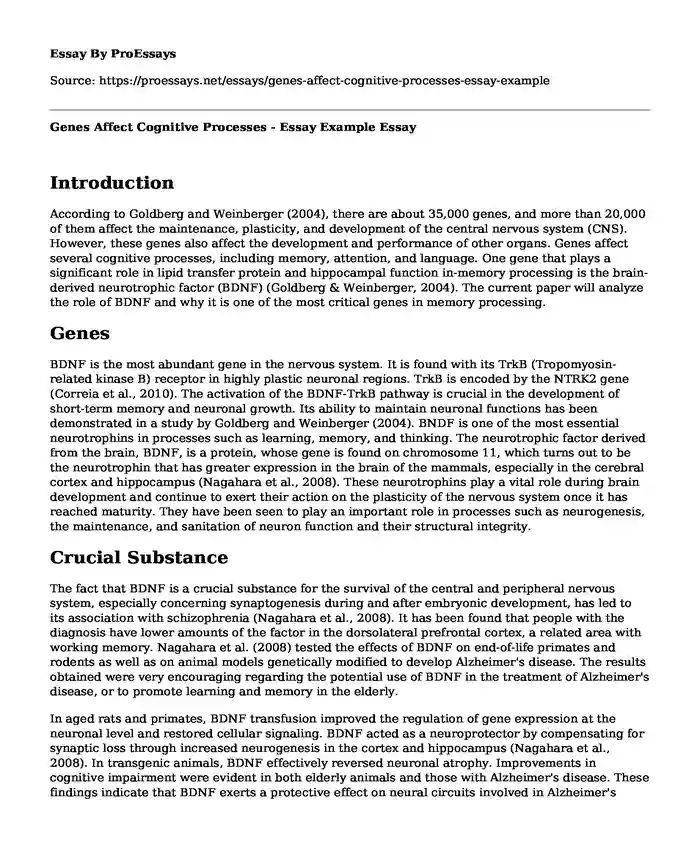Introduction
According to Goldberg and Weinberger (2004), there are about 35,000 genes, and more than 20,000 of them affect the maintenance, plasticity, and development of the central nervous system (CNS). However, these genes also affect the development and performance of other organs. Genes affect several cognitive processes, including memory, attention, and language. One gene that plays a significant role in lipid transfer protein and hippocampal function in-memory processing is the brain-derived neurotrophic factor (BDNF) (Goldberg & Weinberger, 2004). The current paper will analyze the role of BDNF and why it is one of the most critical genes in memory processing.
Genes
BDNF is the most abundant gene in the nervous system. It is found with its TrkB (Tropomyosin-related kinase B) receptor in highly plastic neuronal regions. TrkB is encoded by the NTRK2 gene (Correia et al., 2010). The activation of the BDNF-TrkB pathway is crucial in the development of short-term memory and neuronal growth. Its ability to maintain neuronal functions has been demonstrated in a study by Goldberg and Weinberger (2004). BNDF is one of the most essential neurotrophins in processes such as learning, memory, and thinking. The neurotrophic factor derived from the brain, BDNF, is a protein, whose gene is found on chromosome 11, which turns out to be the neurotrophin that has greater expression in the brain of the mammals, especially in the cerebral cortex and hippocampus (Nagahara et al., 2008). These neurotrophins play a vital role during brain development and continue to exert their action on the plasticity of the nervous system once it has reached maturity. They have been seen to play an important role in processes such as neurogenesis, the maintenance, and sanitation of neuron function and their structural integrity.
Crucial Substance
The fact that BDNF is a crucial substance for the survival of the central and peripheral nervous system, especially concerning synaptogenesis during and after embryonic development, has led to its association with schizophrenia (Nagahara et al., 2008). It has been found that people with the diagnosis have lower amounts of the factor in the dorsolateral prefrontal cortex, a related area with working memory. Nagahara et al. (2008) tested the effects of BDNF on end-of-life primates and rodents as well as on animal models genetically modified to develop Alzheimer's disease. The results obtained were very encouraging regarding the potential use of BDNF in the treatment of Alzheimer's disease, or to promote learning and memory in the elderly.
In aged rats and primates, BDNF transfusion improved the regulation of gene expression at the neuronal level and restored cellular signaling. BDNF acted as a neuroprotector by compensating for synaptic loss through increased neurogenesis in the cortex and hippocampus (Nagahara et al., 2008). In transgenic animals, BDNF effectively reversed neuronal atrophy. Improvements in cognitive impairment were evident in both elderly animals and those with Alzheimer's disease. These findings indicate that BDNF exerts a protective effect on neural circuits involved in Alzheimer's disease (even though it acts through mechanisms independent of the "amyloid cascade") (Nagahara et al., 2008). However, the neurotrophic strategy exploiting the potential of BDNF deserves further research to try a therapeutic application against neurodegenerative diseases or to supplement the cognitive decline encountered with age.
Conclusion
Living in environments that have multiple cognitive stimuli, besides leading a physically active lifestyle, has been linked to having a good cognitive function in general. Cognitive, physical, and visual stimulation translates into a greater neuronal function, increasing synaptic communication between neurons, which implies changes in both the structure and brain chemistry. The cortex first processes sensory stimuli before reaching the hippocampus. BDNF expression is enhanced in environments rich in cognitive stimuli, which has been attributed to be the cause of better memory and learning capacity. This factor would cause more synapses (synaptogenesis), dendrites (dendritogenesis) and, greater neurogenesis to be generated.
References
Correia, C. T., Coutinho, A. M., Sequeira, A. F., Sousa, I. G., Lourenco Venda, L., Almeida, J. P., ... & Cochrane, L. (2010). Increased BDNF levels and NTRK2 gene association suggest a disruption of BDNF/TrkB signaling in autism. Genes, Brain and Behavior, 9(7), 841-848.
https://onlinelibrary.wiley.com/doi/full/10.1111/j.1601-183X.2010.00627.x
Goldberg, T. E., & Weinberger, D. R. (2004). Genes and the parsing of cognitive processes. Trends in cognitive sciences, 8(7), 325-335.
http://delta.colorado.edu/genes&cog.pdf
Nagahara, A. H., Merrill, D. A., Coppola, G., Tsukada, S., Schroeder, B. E., Shaked, G. M., & Rockenstein, E. (2009). Neuroprotective effects of a brain-derived neurotrophic factor in rodent and primate models of Alzheimer's disease. Nature medicine, 15(3), 331-337.
https://www.ncbi.nlm.nih.gov/pmc/articles/PMC2838375/.
Cite this page
Genes Affect Cognitive Processes - Essay Example. (2023, Nov 16). Retrieved from https://proessays.net/essays/genes-affect-cognitive-processes-essay-example
If you are the original author of this essay and no longer wish to have it published on the ProEssays website, please click below to request its removal:
- Anatomy Essay Example on Human Muscles
- Zebras Research Paper
- Genetic Technologies for Effective Care Essay
- Mechanism of Change - Essay Sample
- Essay on My English Journey: Developing Qualities and Improving Shortcomings
- Essay on Unconditional Love Beyond Blood Ties: A Story of My Life
- Parents of ASC Pupils: Supported by School Staff in EHCP Reviews - Essay Sample







